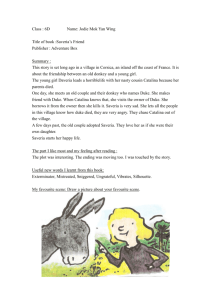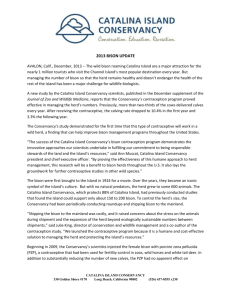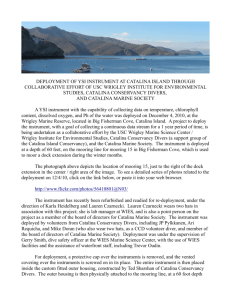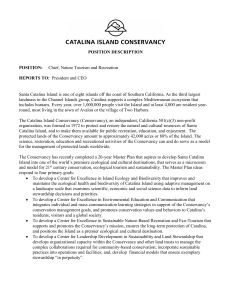Catalina Island Fox: Path to Recovery
advertisement
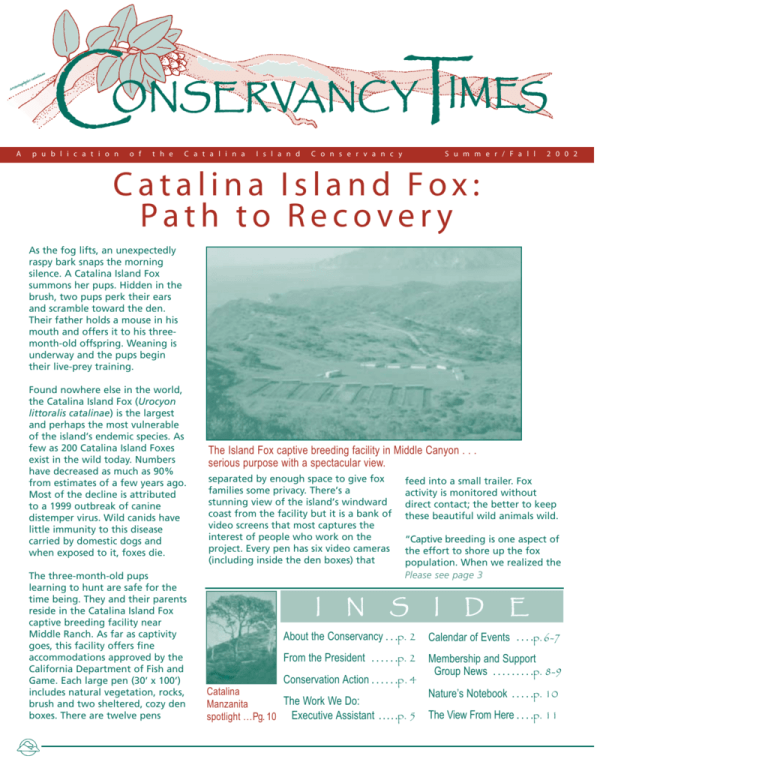
ae talin s ca hylo s tap o t c Ar A p u b l i c a t i o n o f t h e C a t a l i n a I s l a n d C o n s e r v a n c y S u m m e r / F a l l 2 0 0 2 Catalina Island Fox: Path to Recovery As the fog lifts, an unexpectedly raspy bark snaps the morning silence. A Catalina Island Fox summons her pups. Hidden in the brush, two pups perk their ears and scramble toward the den. Their father holds a mouse in his mouth and offers it to his threemonth-old offspring. Weaning is underway and the pups begin their live-prey training. Found nowhere else in the world, the Catalina Island Fox (Urocyon littoralis catalinae) is the largest and perhaps the most vulnerable of the island’s endemic species. As few as 200 Catalina Island Foxes exist in the wild today. Numbers have decreased as much as 90% from estimates of a few years ago. Most of the decline is attributed to a 1999 outbreak of canine distemper virus. Wild canids have little immunity to this disease carried by domestic dogs and when exposed to it, foxes die. The three-month-old pups learning to hunt are safe for the time being. They and their parents reside in the Catalina Island Fox captive breeding facility near Middle Ranch. As far as captivity goes, this facility offers fine accommodations approved by the California Department of Fish and Game. Each large pen (30’ x 100’) includes natural vegetation, rocks, brush and two sheltered, cozy den boxes. There are twelve pens The Island Fox captive breeding facility in Middle Canyon . . . serious purpose with a spectacular view. separated by enough space to give fox families some privacy. There’s a stunning view of the island’s windward coast from the facility but it is a bank of video screens that most captures the interest of people who work on the project. Every pen has six video cameras (including inside the den boxes) that I N feed into a small trailer. Fox activity is monitored without direct contact; the better to keep these beautiful wild animals wild. “Captive breeding is one aspect of the effort to shore up the fox population. When we realized the Please see page 3 S I D E About the Conservancy . . .p. 2 Calendar of Events . . . .p. 6-7 From the President . . . . . .p. 2 Membership and Support Group News . . . . . . . . .p. 8-9 Conservation Action . . . . . .p. 4 Catalina The Work We Do: Manzanita spotlight . . . Pg. 10 Executive Assistant . . . . .p. 5 Natures Notebook . . . . .p. 10 The View From Here . . . .p. 11 C ATALINA I SLAND C ONSERVANCY B M E N E F A C T O R E M B E R S Robert Given, Chair James H. Ackerman Paxson H. Offield Alison Wrigley Rusack B O A R D D O F I R E C T O R S Maria Pellegrini, Chair Geoffrey Rusack, Vice Chair Norris J. Bishton, Jr. Anthony Michaels Johnnie R. Crean Richard Murphy Rose Ellen Gardner Henry OMelveny Richard Harp Calvin Parsons Charles Hathaway Ada Blanche Schreiner Marie Knowles Misdee Wrigley Directors Emeritus A. Douglas Propst E L E C T E D Robert Thorne O J . S c o t t Wa u b e n , Treasurer/Chief Financial Officer Lynn Burt, Corporate Secretary E P A R T M E N T M A N A G E R S Lenny Altherr D i r e c t o r, F a c i l i t i e s M a n a g e m e n t Jane Pulsinelli A s s i s t a n t Tr e a s u r e r Steve Dawes S u p e r v i s o r, S p e c i a l P r o j e c t s David Gardner D i r e c t o r, S e c u r i t y Rebecca Guay D i r e c t o r, V i s i t o r S e r v i c e s Deb Jensen D i r e c t o r, E d u c a t i o n Mark Hoefs D i r e c t o r & C u r a t o r, Paul Moritz D i r e c t o r, A i r p o r t O p e r a t i o n s Peter Schuyler Director, Ecological Restoration Annette Shears D i r e c t o r, Vo l u n t e e r S e r v i c e s J a n e t Ta k a r a D i r e c t o r, J . H . A c k e r m a n Native Plant Nursery Charles Wright D i r e c t o r, D e v e l o p m e n t Wrigley Botanical Garden Contact Us (310) 510 - 2595 editor@catalinaconservancy.org or visit us at 125 Claressa Avenue Avalon, CA Visitor Services hours 8:30 a.m. - 5 p.m. daily 2 Dear Friends, This spring, I had the opportunity to tour the island by helicopter. Wildlife watching is certainly one of my favorite nature activities on Catalina, so a chance to get a glimpse from the air was an exciting treat. From 2,500 feet above, the island is, of course, spectacular. The diversity of habitats and topography resembles a textured 42,000-acre tapestry. As we flew up and down the length of the island scanning ridges and looking into ravines, it was clear that here we have a legacy, a place beloved by generations of visitors and residents. It is also a place teeming with the plant and animal wildlife that is our natural heritage. F F I C E R S R o s e E l l e n G a r d n e r, President/Chief Executive Officer D Fr o m t h e Pr e s i d e n t This issue of the Conservancy Times features articles on two rare/endangered species recovery projects underway on the island. Endangered species recovery programs offer unique challenges; some of which are described in the articles about the Catalina Island Fox and the Bald Eagle. The Conservancy is dedicated to whole-habitat protection. This includes restoration aimed at keeping ecological processes, like natural reproduction, intact. On the ground, wildlife watching is fun. The scurrying Beechey Ground Squirrel and singing Northern Mockingbird are as fascinating to observe as the more elusive Catalina Island Fox or the majestic Bald Eagle. And, it’s good to know that all of these creatures and many, many more are at home here, with us. Best wishes for a wonderful summer! All Over the Globe, Conservation Land Managers are Grappling with Weedy Plants. Invasive non-native species present a huge challenge when it comes to conserving native habitats. On Catalina, we have had an active weed abatement program for many years. On July 13-14, teams of staff and volunteers commenced a weed mapping project designed to up the ante for successful weed management. Then, on August 2, a group of science teachers visited the island as part of the California K-12 Alliance Summer Institute which focused this year on .weeds. The science teachers learned about our weed strategies and restoration projects. Prevention through education. Catalina Island Conservancy Life on the Edge continued from page 1 extent of the fox problem, we had to act very quickly to stabilize the decline. We convened all experts and built a recovery plan that included vaccination, translocation, and captive breeding. The Institute for Wildlife Studies (IWS) is the Conservancy’s partner in this effort,” stated Peter Schuyler, the Conservancy’s Director of Ecological Restoration. Island Foxes mate and produce only one litter per year. This spring, six female foxes of the ten pairs in captivity delivered pups. While data from foxes in the wild is not available to know the usual litter size and rate of survival, the facility is allowing us to provide a stable, controlled environment for foxes to rear their young, and represents an exceptional opportunity to learn more about these striking animals, and what they need in order to thrive. During the twoyear-old project, the average litter size has been two pups. In 2001, 33% of the pups survived and in 2002, 57% survived. The 2002 pups will remain in the pens until fall, but the six born last year have been liberated to fend for themselves. The whole purpose of the captive breeding program is to restore the population of foxes in the wild. The six juveniles released last November are wearing radiotelemetry collars so that movements and interactions can be observed. Twenty others have been ear-tagged, radio collared, and translocated from the west end of the island to the east end. The West End population remained intact during the canine distemper virus epidemic. When the foxes were captured on the West End, each was given a complete physical examination to be sure only healthy foxes were moved. Telemetry tracking has found that there is considerable overlap in the use area of some male and female translocates which indicates pair formation. This is a sign that the new East End residents are establishing home territories and bonds that may mean more pups born in the wild next spring. In 2000, a canine distemper vaccine pilot study indicated that the vaccine, developed by Dr. Richard Montali of the National Zoo, was safe and effective for Catalina Island Foxes. In 2001, 80% of foxes that survived the distemper outbreak were vaccinated. According to Steve Timm, veterinarian for IWS, “The vaccinations should provide the fox population with some resistance to outbreaks of canine distemper, but the possibility of future distemper outbreaks or other diseases is still very real.” A project with the significance and magnitude of the Catalina Island Fox Recovery Program could not have been possible without the generous donations of numerous members, donors, and foundations. Many volunteers continue to give of their time to assist the Conservancy and the Institute for Wildlife Studies in the recovery program. Please do your part to help save the Santa Catalina Island fox, a living symbol of what makes the island unique. Here’s how: Don’t feed the foxes. They can become drawn to L people, which makes them vulnerable to unhealthy foods, pet diseases, and deadly road crossings. L Always keep your pets on a leash in the interior of the island. Though they should, foxes don’t have much fear of larger animals, perhaps because they have had no natural enemies on the island for thousands of years. L If you see a hurt, injured or dead fox, please do not attempt to move it. Call the Catalina Island Conservancy at 510-2595 to report it immediately. L Contribute to the Fox Fund c/o Catalina Island Conservancy, P.O. Box 2739, Avalon, CA. 90704. In November, the healthy pups born in captivity this spring will be collared and released. It might take the juveniles some time to adjust to the big, wide world. Soon they will learn how to find Jeruselum crickets, manzanita berries, sheltered overhangs, and potential mates. Welcomed into the island’s natural community, they represent hope for the Catalina Island Fox Recovery Project. - - Deb Jensen Director, Education Tracks in the Sand - Saving the Catalina Island Fox, an award winning documentary now available for purchase. See Page 12. Conservancy Times 3 Conservation Action “Number 31” Bass Lake, CA April 30, 2002 In 1993, a two-week old baby female Bald Eagle was collected from a nest in Northern California and placed into the West End nest on Santa Catalina Island. She was banded and tagged with tags “31”. Eagle chick awaiting transportation to new nest. She fledged and one day left the nest. The Institute for Wildlife Studies (IWS) and the Conservancy lost track of her until she was spotted in Washington State in 1995. Then, in 1998, she showed up at Bass Lake with an adult male adding sticks to an old osprey nest but too late for the breeding season. Her mate was smaller and untagged. In 1999, the pair was again sighted at the Bass Lake nest and successfully raised an offspring. It also appears they raised two eaglets in 2000 and two in 2001. Laura Colton of the California Department of Fish and Game in Oakhurst, California reported that this past February the pair was incubating eggs in the nest. The orange “31” patagial (wing) tags were plainly visible on the female. It was anticipated that the egg(s) would hatch around mid-March, but by late March it was clear that the nesting attempt failed for some reason. There was hope that a renesting attempt would be made since the two eagles were still in close proximity to the nest. In April, two Bald Eagles were sighted perched on the nest, however, neither was tagged. Additional observations confirmed this. It appears that the smaller of the pair is the male that had previously mated with “31”. But the female is not “31”. The two unmarked eagles have formed a pair bond and have been sighted soaring synchronously above the nest and were observed All Creatures chasing another unmarked eagle from the nest territory. There has been no sighting of “31”. Great and Small The Department of Fish and Game is concerned with the fact that “31” is missing. Bald Eagles are extremely long-lived birds and “31” appeared to be in great condition. Bald eagles breed for life so it is unlikely that she would have abandoned her nest territory. There have been no reports of the missing eagle. It is unknown what happened to “31”. Did she become ill or injured somehow? Did she become tangled in fishing line in the many lakes in the area? It is unlikely that she would have lost both patagial tags so one or both should still be visible if she were spotted. The Bald Eagle population in the Bass Lake area appears to support “floaters” – adult Bald Eagles that reside in an area but have not established a pair bond or nesting territory. It is assumed that the new female in the nest of “31” is a floater that quickly filled the void left by the missing “31”. It appears this female floater has now paired with the remaining male. Endangered species recovery programs (like Catalina’s Bald Eagle Project) are fraught with challenges. Mating success is only one of the trials. Animals in low populations have few mate choices and natural biologic factors may inhibit mate selection. Even one healthy adult in an endangered population can make a significant difference in an animal species’ survival. The Conservancy is dedicated to whole habitat protection and restoration aimed at keeping ecological processes, like natural reproduction, intact. On Catalina Island, natural reproduction by Bald Eagles is currently not possible because of the continued impacts of DDT pollution, such as the thinning of the Bald Eagles’ egg shells. In order to allow the eagles to continue to persist here, the Institute for Wildlife Studies conducts a management program in which they remove the fragile eggs before they break, replace them with artificial eggs, and then foster healthy chicks back into the nest. These chicks are either produced by the San Francisco Zoo’s seven breeding pair of Bald Eagles, hatched from the Catalina eggs, or are collected from wild nests, as “31” was in 1993. 4 Catalina Island Conservancy The Work We Do Executive Assistant After 17 years with the Catalina Island Conservancy, Lynn Burt has retired as Corporate Secretary and Executive Assistant. Lynn started with the Conservancy on October 14, 1985. Over the years, she has been involved in all meetings of the Board of Directors and Benefactor Members, from arranging logistics to preparing official notices, agendas, and recording the minutes of the meetings. In this capacity she was custodian of the corporate seal, bylaws, minutes, and corporate files. In her administrative duties, she assisted the president and other senior management staff in a myriad of ways in the day-to-day operations of the Conservancy. Lynn was also instrumental in creating and publishing the popular weekly employee newsletter, Fox Tales. “I am very proud of my years with the Conservancy and the role I have been fortunate to play in the care and preservation of Catalina,” Lynn said, “and now that I’m retired I will be able to reap the benefits by spending more time enjoying the island . . . boating, camping, hiking, etc.! Lynn Burt Bruce Guay joined the Conservancy family on June 17, 2002, and officially took over Lynn’s position on August 1. Bruce brings to the position experience in computer programming, office management, and excellent organizational and writing skills. “No one can replace Lynn,” Bruce said, “but I look forward to working with the Benefactors, Board, executive staff, and all the staff at the Conservancy. My orientation tour of the various departments reinforced my belief that this is an organization I will be proud to assist in any way I can to further its mission.” Conservancy Times 5 CALENDAR Your guide to getting E DUCATION O FFERINGS Aug 20, Evening Nature Program 8:00 p.m. "Catalina Views" is the year's work from island photographers. Come see what developed. Wrigley Botanical Gardens. Sept 1, The HIKE 8:00 a.m. Experience the spectacular coast above Little Harbor. Reservations must be made by Aug. 31. Sept 17, Evening Nature Program 7:00 p.m. Denise Knapp, Conservancy vegetation specialist, will share with us what is going on in the Goat Harbor burn area. Metropole Hotel Conference Room. Oct 5, The HIKE 8:00 a.m. Walk on a trail of beauty from Black Jack to Middle Ranch. Reservations must be made by Sept. 28. Nov 2, The HIKE 8:00 a.m. TBA. Reservations must be made by Oct. 26. Nov 19, Evening Nature Program 7:00 p.m. Learn about Catalina's resident and visiting bird species in preparation for the Audubon Christmas Bird Count. Metropole Hotel Conference Room. Dec 7, The HIKE 8:00 a.m. EXTREME HIKE. Head into Toyon Bay from Airport Rd. Reservations must be made by Nov. 30. Want to join in on an education program? Contact the Education Department (310)510-0954 or education@catalinaconservancy.org V OLUNTEER H APPENINGS Volunteer Vacations Volunteer Vacations are an exciting change of pace from the usual vacation. Your experience will serve as an excellent opportunity to learn about the unique ecology of Santa Catalina Island, give back to the environment, and have some fun at the same time. Sept 9 - 13 Sept 23 - 27 Volunteer Vacation Volunteer Vacation (sold out) Check the next issue of the Conservancy Times or our web site for Volunteer Vacations dates in 2003. Nurture the Natives . . . Every Thursday Join staff and volunteers at the James H. Ackerman Native Plant Nursery for a variety of projects with "the natives." Planting, watering, seed processing and general maintenance are just a few of the projects we'd like to share. Sept 4, 9, & 11 Volunteer Naturalist Corps Basic Training Be a Leader, help teach our school-age children the value of this beautiful ISLAND and all the wonders that come with it. Wednesday, Sept. 4, starts the training for our school-aged programs. The first day consists of basic teaching methods and ideas, with an overview of our local island environment. Monday, Sept. 9, will incorporate specific lesson plans for the Catalina ISLAND program which works directly with K-6 Avalon and Two Harbors School children. The last training, Wednesday, Sept. 11, will be a hands-on experience with Course Catalina. This program began in 1995 as an outreach program for middle school students in the Los Angeles Unified School District and is co-sponsored by the Catalina Island Conservancy and the Boone Foundation. Please join us for a chance to help carry on the knowledge. M EMBER G ROUP E VENTS October 19, Catalina Marineros 2002 Fall Cruise. Plans are underway for a cruise to Corsair Yacht Club Cove at Emerald Bay. Please see article on pg. 9. 8 TH 6 Would you like more information about these and other volunteer opportunitites with the Catalina Island Conservancy? Call Director of Volunteer Services Annette Shears at (310) 510-2595, ext. 102 or email volunteers@catalinaconservancy.org Save the Date - Saturday, April 5, ANNUAL CATALINA ISLAND CONS Catalina Island Conservancy . . . g n i r u t Fea R involved on Catalina S UMMER N ATURALIST P ROGRAMS THROUGH S EPTEMBER 1 ST Sundays, Avalon Nature Hike 9 a.m. Come join us as we take a moderate uphill climb to the back of Avalon Canyon for spectacular views. Wrigley Memorial and Botanical Gardens. Tuesdays, Avalon Nature Walk 10 a.m. Enjoy a leisurely stroll through the gardens led by our knowledgeable naturalist guide. Wrigley Memorial and Botanical Gardens. Catalina Views . . . a slide exhibition that catches Catalinas wilder side. Fridays, Avalon Campfire Program 8 p.m. Gather around for stories, legends and facts about Catalina’s history at the evening campfire. Hermit Gulch Campground. Saturdays, Avalon Nature Walk 10 a.m. Enjoy a guided leisurely stroll through the botanical gardens led by our knowledgeable naturalist. Wrigley Memorial and Botanical Gardens. Saturdays, Two Harbors Nature Walk 10 a.m. Explore the natural history of Two Harbors as we take a leisurely stroll at the Isthmus. Meet at the Conservancy Kiosk. Volunteers bring environmental education to local school children. Saturdays, Little Harbor Nature Walk 3 p.m. Join us as we take a closer look at one of Catalina’s sensitive ecological areas. Meet at Little Harbor Campground kiosk. Summer Naturalist Programs are FREE and open to the public (admission for the Wrigley Memorial and Botanical Gardens is $3.00 for adults). Reservations are not required. For more information call (310) 510-2595, ext. 134. 2003 SERVANCY Conservancy Times BALL Make your plans for the Catalina Marineros 2002 Fall Cruise. Memberships Move Us A warm welcome to our new members! (3-1-2002 through 5-31-2002) GOLDEN CIRCLE AMIGOS CATALINA PILOTS FRIENDS James and Helen Rosburg James and Karen Young GOLDEN CIRCLE MARINEROS CATALINA CONSERVANCY DIVERS John and Marilyn Adair Trygue and Lyla Anderson Tom Asfor and Nena Dols Robert Bass Mark and Bonnie Beck William and Mary Borneman Bernadette and Tyrone Byrd Carol Dalton John and Edith Daniels Peter Fiske and Kelly Kirkpatrick Lee and Pat Freeman Patricia Fritcher Ellen Fusco Joseph Grelck Matt and Nancy Grimes Lynn and Beverly Haller John and Sherrie Harloff Tish Harper Bob and Debi Lambert Daniel Marquez Hans and Annerose Grellmann Joseph and Marie Michell Joseph Moreno and Rosie Ramirez Wilson and Carol Pace Charles and Nelly Shemell The Spence Family and John Graham Peter and Virginia Stillman Diane Stojanovich Books Rodney Yoder and Juliette Wells $1000 annual dues $1000 annual dues Richard and Susan Vanderpool AMIGOS $100 annual dues Gail Avedesian Lynn Danielson and Fred Smith Marilyn Grams Karla Parsons Paige Wright $100 annual dues $100 annual dues Eric Edward and Lisa Lundquist Paulie Jenkins and Ted Carlsson Everett Mundkowsky Ted Phelps Danny and Ellie Piper William Powers Tony Wilcox Stephanie Wilson CATALINA CABALLEROS $100 annual dues CATALINA MARINEROS $100 annual dues Peter Binaski Donald and Margie Brown Charles and Marilyn Campman Orlando Duran and Linda Richards Craig Leeds and Margie Cate Robert Malone Bob and Donna McGill Steve and Glynns Mueller Tom Rogers Robert and Susan Weekly Robert and Judith Herron STUDENTS $10 annual dues Nic Tasca ISLAND RESIDENTS $25 annual dues Eric Huart Lisa Malone Peter Trottier and Lori Brady OF CATALINA $25 annual dues Join Us! For further information about membership and contributions, please contact: Development Director Chuck Wright at (310) 306-3577, ecofunder@aol.com, or Erica Cushing, Development Assistant, at (310) 510-2595, x 114, ecushing@catalinaconservancy.org 8 Catalina Island Conservancy Support Group News Catalina Marineros Hey Marineros! Here’s your chance for some fun this fall. Join the group going to beautiful Emerald Bay on the weekend of October 19 and 20. Corsair Yacht Club has graciously offered their shore facilities for us to enjoy. Moorings will be available for those who sign up early. There will be a great barbeque dinner on Saturday evening; bring your own libation. Conservancy naturalist, Jeff Chapman, will provide an educational program and will answer any questions about the Conservancy that you may have. Enjoy games and activities on shore starting at 11:00 a.m. on Saturday. A low-key horseshoe tournament is planned and there will probably be a bingo game going. A dinghy raft cocktail party is in the offing. Come prepared to have a great weekend! Also, charcoal fires will be available for those of you who wish to barbecue dinner ashore on Friday night. The best part of this is the cost, only $22.00 per person. Send your reservation in the form of a check for the total amount to Catalina Island Conservancy, P.O. Box 2739, Avalon, CA. 90704, attention Erica. To make mooring arrangements, include your boat name, length and whether it is sail or power. If you have questions, call Dave Hitchcock at (310) 373-9491 and he will try to answer them. Put this on your schedule now!! L L L L Marineros work projects are scheduled every month and we’re always looking for eager helpers. It’s a fun trip starting with an early Catalina Express ride to Avalon (6:30 a.m.) from Long Beach and a full day’s activities. The jobs are varied but interesting and it makes a great two-day trip. Want to participate or have questions? Call Hank O’Melveny, (626) 799-9532, or Thad Jones, (949) 494-5505. Two New Member Support Groups Conservancy members at the $100 annual dues level can choose to belong to one of several support groups – the Catalina Marineros for boaters, the Catalina Conservancy Divers for scuba divers, the Catalina Caballeros for equestrians, and the Catalina Amigos. The two newest member support groups are the Catalina Conquistadors and the Catalina Pilots. Besides supporting the Conservancy, the members of the Catalina Conquistadors enjoy athletic competition of various kind;, including biking, 10K’s and triathlons; on and throughout the island. The members of the Catalina Pilots are not only supportive of the Conservancy’s overall work, but enjoy planes and flying and are particularly interested in visiting Catalina’s Airport-in-the-Sky. Both groups are welcoming new members. Membership in any of the support groups is open to all persons. You can check out all of the groups on our web site by clicking on BECOME A MEMBER. Or, call Erica Cushing in our membership department at (310) 510-2595, x 114. Conservancy Times 9 Natures Notebook Manzanita, Stark and Stunning Arctostaphylos may be one of the most adaptable genera in the western United States. In California there are nearly ninety varieties of this plant, better known as manzanita. The common name is Spanish for “little apple”, which the small fruits resemble. The plants readily adapt to fit climate, soil composition and other physical geographic features, becoming endemic species with a limited range. Endemic manzanita can be found on Santa Cruz, Santa Rosa and Santa Catalina Islands. The Santa Catalina Island Manzanita (Arctostaphylos catalinae) is found in several groves around the island. Some individual plants resemble large shrubs or even trees. The manzanita’s most striking characteristic is its brilliant smooth, shiny, red bark. Catalina Manzanita Catalina manzanita are associated with the many organisms that make them home. Some branches are crusted with the varied colors and species of lichen. Hummingbirds and flying insects feed on nectar from the flowers. Catalina quail and Spotted towhees can be seen foraging in the leaf litter beneath the shrubs. The Catalina Island Fox has a special relationship with manzanita, the berrries being a favorite fox food. The seeds contained within the berries require scarification in order to germinate. Often fire helps scarify the seeds, however, the churning digestion within the stomach of a fox also does the trick. When foxes leave scat away from the parent plant, they are helping to extend the range of the manzanita on Catalina. Consequently, this means more food sources for future Island Foxes. Eric’s Journal . . . a young naturalist’s Catalina Eric Williamson is a sixth grader at Avalon Elementary School. He is a Conservancy Island Scholar and spent one day per month, during the school year, at a special spot near Black Jack. There he, and the other Scholars, made observations about Santa Catalina Island. A habitat is a place where an animal or plant naturally lives or grows. An example of a native Catalina habitat is a fox den. A fox den is a burrow in the ground that the animal made or uses that another animal has made. A burrow is used for hiding from predators, to survive in stormy weather, to keep cool when the weather is too hot outside and to keep their pups safe. Around my spot at Black Jack, I found a fox, birds and squirrels. The bird had a nest and I found feathers on the ground and on the branches. There was a hole in the ground for the fox for shelter. I also saw fox scat in my spot. I also saw another hole that I saw the squirrel go into. The birds and the squirrel share the same habitat, the tree. They both use the tree to hide in. They both use the tree for raising their young. They both use the tree for storing their food and protection. 10 Catalina Island Conservancy The View From Here Lines composed while HIKING to White’s Landing Ancient rock gently crumbling Green hills majestically climbing Spectacular island delightfully singing Tall ironwoods longingly reaching Crystal life form silently pounding Colorful grasses softly bending Green plant starkly growing Gorgeous bird freely singing Brown rock majestically standing Old island patiently waiting Energetic hike lively moving… Written by: Two Jims, Tim and Pat, Joyce, Jeff, Mike Rocosam, Alma, Susan, Teresa and Lisa Come along on a HIKE with the Catalina Island Conservancy. The first Saturday of each month we take a different path, to a different place. Spend some time with your feet on the earth, in motion with others. On this page, we welcome your thoughts, musings, sketches, and photos of Catalina. Please submit to: Editor, Conservancy Times P.O. Box 2739 Avalon, CA 90704 All items become the property of the Catalina Island Conservancy. Conservancy Times 11 Tracks in the Sand Saving the Catalina Island Fox This award winning film documents the first year of the Conservancy’s historic Fox Recovery Project. Journey with wildlife biologists, Conservancy staff, local students and the Catalina Island Fox into the interior of Catalina to witness efforts to save this special species from extinction. Purchase your copy when you are on the island at: Conservancy House 125 Claressa Ave., Avalon Catalina Island Conservancy P.O. Box 2739 Avalon, California 90704 www.catalinaconservancy.org The mission of the Santa Catalina Island Conservancy is to conserve the land it owns in perpetuity; to restore it to a natural state; to provide education and recreational uses of the land consistent with conservation; to foster and develop research to promote understanding of the resources of Santa Catalina Island and Conservancy activities and to promote an understanding of the underwater habitat surrounding the Island. Printed on 100% recycled post-consumer waste paper with vegetable-based ink.
